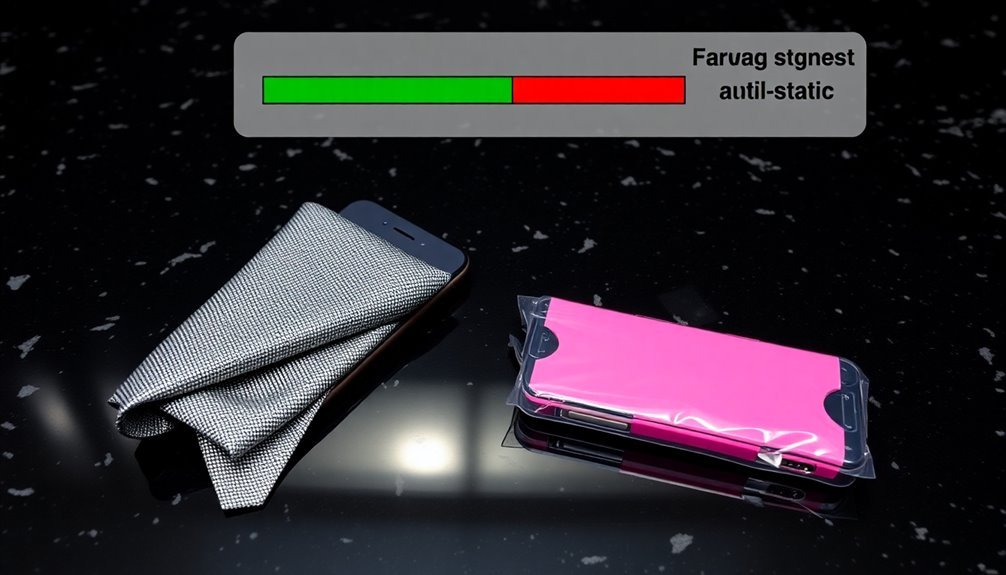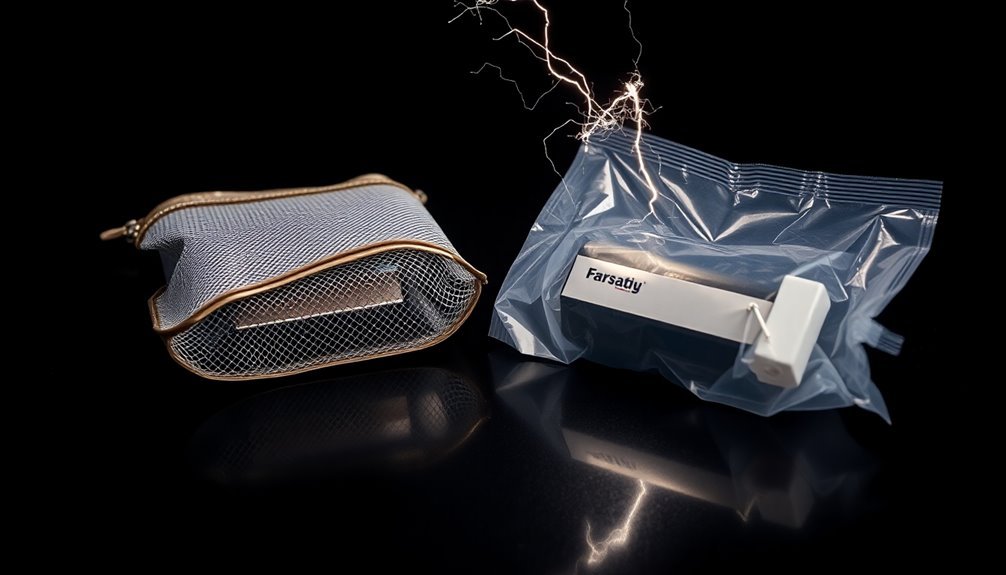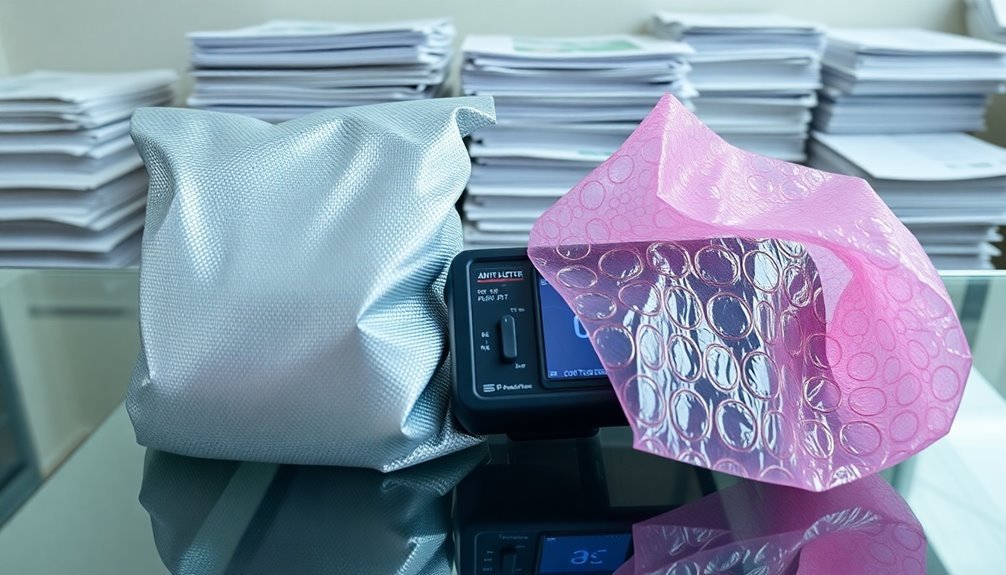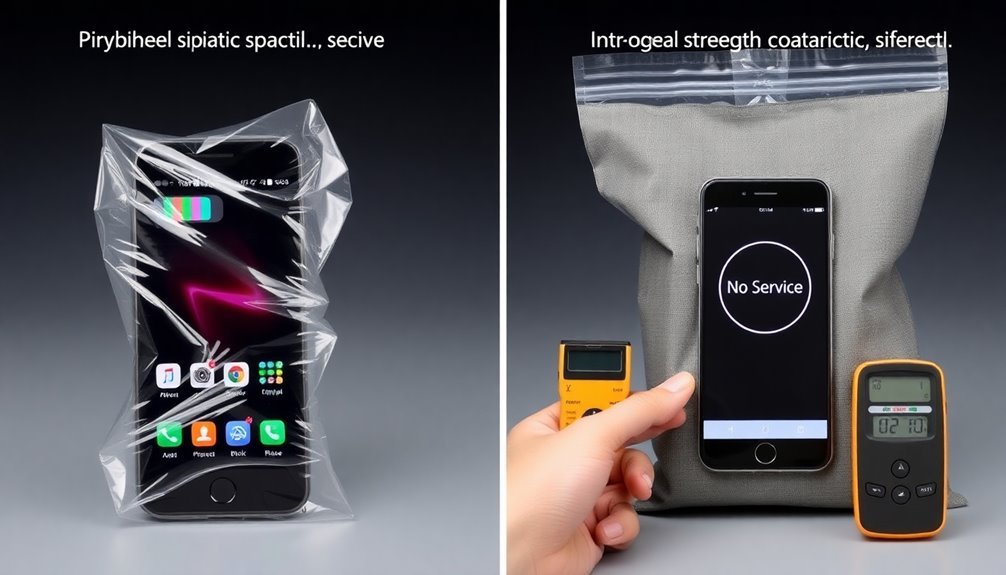Faraday bags outperform standard anti-static packaging by offering notably stronger protection for your sensitive electronics. While anti-static bags only guard against basic static buildup, Faraday bags utilize multi-layered metallic construction that shields against both static fields and electromagnetic interference – providing up to 40 times more protection. You'll benefit from their superior durability, which means less frequent replacements and better long-term cost efficiency. These robust bags also create an effective moisture barrier when sealed properly, making them ideal for shipping high-value components. The extensive protection they offer makes a compelling case for exploring their full range of advantages.
Understanding Faraday Versus Anti-Static Protection

Two distinct technologies protect electronic components from electrical damage: Faraday bags and anti-static packaging. While both serve protective functions, they operate on fundamentally different principles and offer varying levels of defense for your sensitive electronics.
Faraday bags employ a sophisticated multi-layered construction that includes a metallic layer creating a protective cage effect. This design shields your devices from external static electric fields while providing extensive ESD protection. The aluminum shielding layer makes these bags significantly more durable than standard anti-static options. Regular moisture vapor barrier options provide additional protection against environmental factors.
You'll find these bags particularly effective in both preventing static buildup and protecting against electrostatic discharges from inside and outside the container.
In contrast, anti-static bags offer a more basic level of protection. They're made from polyethylene with anti-static additives, making them semi-transparent and cost-effective.
While they'll prevent static electricity buildup, they won't protect your components from ESD events. You'll want to take this limitation into account when choosing packaging for your electronic items.
When handling highly sensitive electronics or planning for long-term storage, you'll need Faraday bags' superior protection.
They're especially significant in environments prone to static buildup or when dealing with military-grade components requiring MIL-PRF-81705 compliance.
Choose anti-static bags only for non-sensitive components and short-term storage needs.
Superior Construction Makes the Difference
Deep within the layers of static shielding bags lies their superior protective capability.
You'll find multiple layers working together, including a metalized layer that creates a powerful Faraday cage effect, alongside static dissipative coatings on both inner and outer surfaces. This sophisticated construction blocks up to 97% of 1,000-volt pulses that might otherwise damage your sensitive electronics. These bags continuously remove static charges through their specialized coatings. Pink and black options offer varying levels of protection for different applications.
When you're dealing with valuable electronic components, you'll appreciate how these bags protect against both internal and external static charges.
Their multi-layer design doesn't just shield against ESD; it also creates an effective moisture barrier when properly sealed. You're getting extensive protection that meets stringent military specifications in many cases.
You'll need to take into account that these bags cost more than standard anti-static packaging, but their durability and protection level justify the investment.
While you'll need to verify proper sealing and might require extra padding for sharp objects, you're getting superior physical protection along with ESD safeguards.
For environments with frequent handling, temperature fluctuations, or high humidity, static shielding bags provide the robust protection your sensitive electronics need.
Complete ESD Protection Solutions

Working toward thorough ESD protection requires more than just selecting the right bag – you'll need a complete system of safeguards. When you're dealing with sensitive electronics, Faraday bags deliver extensive protection through their multi-layer construction and Faraday cage effect, while standard anti-static bags only provide basic static dissipation. Pink antistatic bags are particularly limited in their protective capabilities, being made only from LDPE polyethylene with basic antistatic additives. Charge dissipation occurs more slowly with standard anti-static bags compared to shielding options.
To maximize your ESD protection strategy, you'll want to verify your Faraday bags are properly sealed, as any gaps can compromise their effectiveness. You should also add protective padding for items with sharp edges to prevent punctures that could destroy the bag's shielding properties. While these requirements might seem demanding, they're essential for maintaining the integrity of your ESD protection system.
When you're shipping or storing ESD-sensitive components, don't compromise on protection – standard anti-static bags won't shield your products from external static fields or ESD events. Instead, invest in certified static shielding bags that meet industry standards like MIL-PRF-81705.
They'll provide complete protection through their three-layer construction: a static dissipative inner layer, a metallic middle layer, and a protective outer layer. This extensive approach guarantees your sensitive electronics remain safe from both static buildup and discharge.
Real-World Applications and Benefits
Real-world applications of static shielding solutions demonstrate clear advantages over basic anti-static packaging. In electronics manufacturing, you'll find static shielding bags protecting sensitive PCBs and ICs while meeting strict MIL-PRF-81705 standards. These solutions create a Faraday cage effect that guards against both external and internal static charges. The implementation of multi-layer shielding pouches provides unmatched protection for the most sensitive electronic components. These bags feature a four-layer construction that includes static dissipative polyethylene and aluminum shielding for maximum protection.
| Industry | Application | Key Benefit |
|---|---|---|
| Electronics | Component Storage | Total ESD Protection |
| Aerospace | Transport Security | Meets Military Standards |
| Defense | Critical Parts | Enhanced Shielding |
| Cleanroom | Manufacturing | Static-Free Environment |
When you're working in static-sensitive environments like cleanrooms or electronics facilities, you'll need the superior protection that static shielding bags provide. They're particularly essential for high-reliability industries such as aerospace and defense, where component failure isn't an option.
You'll find specialized options like ESD bubble wrap bags for delicate items and multilayered bags that offer additional moisture protection. Unlike standard anti-static packaging, these solutions provide thorough protection against static buildup, ESD, moisture, and oxidation. For your high-end electronics and sensitive components, static shielding bags aren't just an option – they're a necessity for ensuring total protection throughout storage and transport.
Cost Analysis and ROI

A thorough cost analysis reveals significant differences between Faraday bags and anti-static packaging options.
While you'll initially pay more for Faraday bags due to their multilayer construction and advanced protective features, the long-term ROI often justifies this investment, especially when you're handling sensitive electronic components.
When you're calculating costs, consider that Faraday bags meet stringent military specifications like MIL-PRF-81705, which can protect you from costly compliance issues.
Though anti-static bags are cheaper upfront, they only prevent static buildup and won't shield your components from external ESD threats. The surface resistance range of static dissipative bags between 10 kilohms and 100 gigohms makes them inadequate for complete protection. You'll find this limitation particularly problematic when shipping high-value electronics outside controlled environments.
You can expect significant long-term savings with Faraday bags through reduced component damage and fewer replacement needs.
Their superior durability means you won't need to replace them as frequently as anti-static bags.
If you're handling sensitive electronics, the cost of potential ESD damage using standard anti-static packaging can far exceed the initial price difference.
For high-volume shipping of non-sensitive items within ESD-controlled areas, anti-static bags remain a cost-effective choice, but for valuable electronics, Faraday bags deliver better financial returns.
Frequently Asked Questions
Can Faraday Bags Be Reused, and How Many Times Before Losing Effectiveness?
You can reuse Faraday bags, but there's no universal limit. Their effectiveness depends on physical condition, proper storage, and manufacturer guidelines. You'll need to inspect them regularly for damage before reuse.
Do Temperature Extremes Affect the Protective Properties of Faraday Bags?
Yes, temperature extremes can affect your Faraday bag's effectiveness. You'll notice both heat and cold can impact the material's integrity, conductivity, and seal quality, potentially compromising its protective shielding capabilities.
What's the Average Shelf Life of Unused Faraday Bags in Storage?
Your properly stored Faraday bags can last 5-10 years when kept in dry, temperature-controlled conditions. You'll need to inspect them regularly for signs of degradation and guarantee they're sealed to maintain their effectiveness.
Are There Specific Cleaning Methods for Maintaining Faraday Bags?
You'll want to use a soft, dry cloth or brush to remove dust. Don't use chemicals or detergents. Keep cleaning gentle and avoid moisture. Always inspect the bag for damage before reuse.
How Quickly Do Faraday Bags Lose Effectiveness if Their Seal Is Damaged?
Your Faraday bag loses its protective properties immediately when the seal is damaged. You'll have no effective static shielding as even the smallest gap lets external charges penetrate, compromising the entire Faraday cage effect.
In Summary
You'll find Faraday bags offer considerably better protection than standard anti-static packaging through their multi-layered shielding and complete electromagnetic isolation. They're worth the higher initial investment, delivering superior ESD protection and signal blocking that basic anti-static materials can't match. When you're protecting sensitive electronics, Faraday bags provide the all-encompassing security you need in today's high-tech environment.





Leave a Reply